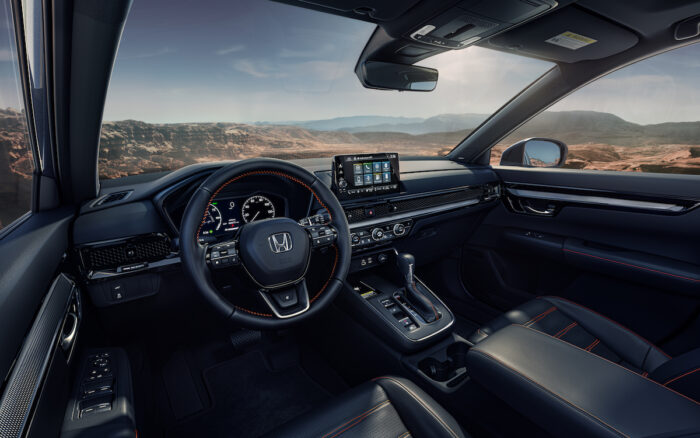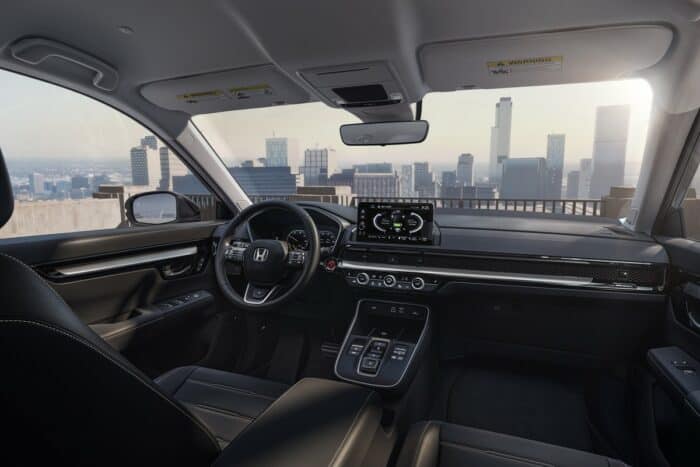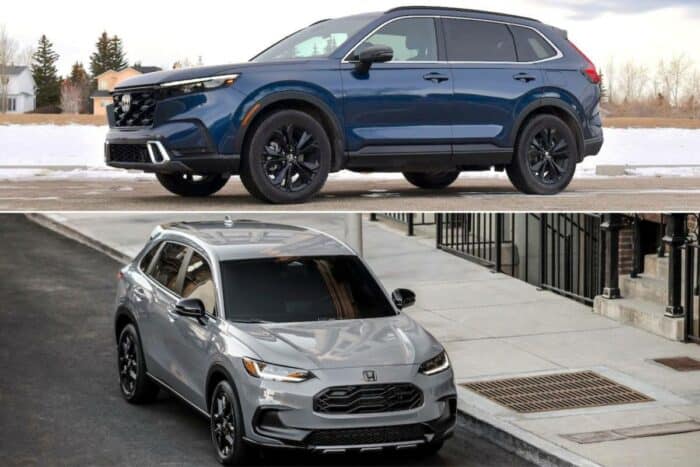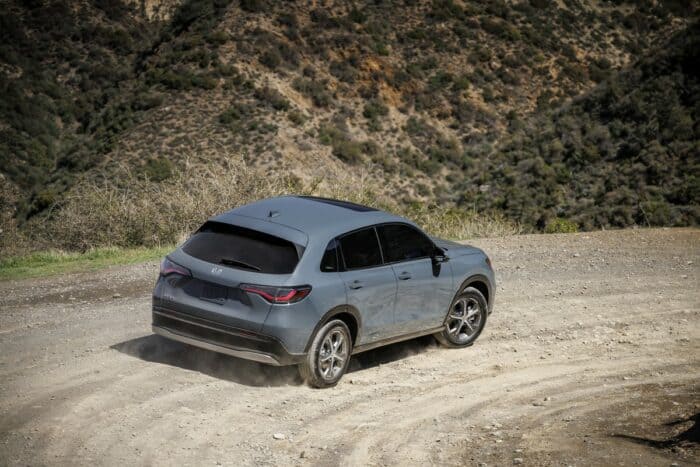Honda’s two smallest SUVs were both all-new for the 2023 model year. Regarding the latest updates, the 2024 HR-V is available with Real Time All-Wheel Drive (AWD) with Intelligent Control; and the new 2025 CR-V is America’s first production plug-in hydrogen fuel cell electric vehicle.
This CR-V vs. HR-V comparison covers:
- Size and dimension differences
- Interior and cargo space
- Performance and engines
- Fuel economy
- Driving impressions
- Takeaway
Sizing Them Up: How the HR-V and CR-V Compare in Dimensions

The decision to move the latest-generation HR-V out of the subcompact class brings it much closer in size and capability to the larger CR-V, even though the two vehicles look very different. Overall, they’re intended to be complementary. Honda opted not to bring the HR-V sold to the US and Canada in other world markets. Instead, it’s selling a car known elsewhere as the ZR-V, badged here as the HR-V. This model is larger than the previous, subcompact HR-V, narrowing the gap to the CR-V redesigned in 2023.
At 4,568 mm / 180 inches in length, the HR-V is now only 127 mm / 5 inches shorter than the 2023 CR-V, when previously the size difference was double that. With a width (mirrors folded) of 1,894 mm / 74.6 inches, the 2023 HR-V is only 46mm / 1.8 inches narrower than the current CR-V. The CR-V’s boxier silhouette means that in AWD form, it stands 70 mm / 2.7 inches higher than the more car-like HR-V. However, this barely makes any difference between the two cars in front and rear headroom.
Exterior Dimension Differences:
| Spec | CR-V | HR-V |
|---|---|---|
| Wheelbase | 106.3″ | 104.5″ |
| Length | 184.8″ | 179.8″ |
| Width | 73.5″ | 72.4″ |
| Height | FWD: 66.2″ AWD: 66.5″ | LX: 63.4″ Sport: 63.8″ EX-L: 63.4″ |
Interior Showdown: Why the CR-V Offers More Room for Your Gear

The HR-V’s increased exterior size translates to generous interior space, although in the areas that arguably matter most, there’s still less room than in the CR-V. It, too, was enlarged when the current generation was launched in 2022 and has a helpful 84 mm / 3.3 inches more rear legroom than the HR-V and 170mm / 6.7 inches of extra width in the rear seat. You’ll certainly notice the difference if you regularly carry adults in the back, but the HR-V still has lots of space for kids.

CR-V is the better choice for cargo space
If hauling gear is your priority, then you’ll want the CR-V. With 1,113L (39 cu.ft) of volume behind the rear seats, it has 75% more cargo space than the HR-V, which offers only 691L (24 cu. ft). Due to the underfloor battery pack, the CR-V Hybrid loses about 10% of its cargo volume compared with the gas-only model. Regarding the cabin design, we feel the HR-V is second to its larger sibling. The CR-V’s elegant dashboard and door panels are a step up from the HR-V’s interior regarding both looks and materials, while the build quality is better in the CR-V, too, at least in the test vehicles we drove.


Both small Honda SUVs come well-equipped
Specification-wise, Honda keeps things easy by limiting optional equipment. The HR-V and CR-V are well equipped, especially in the higher Sport and EX-L grades, with essentials like Honda Sensing driver assistance systems and Apple CarPlay and Android Auto integration standard on all models.

The two cars share some switchgear – including the appealingly chunky rotary dials for the HVAC controls – as well as their central touchscreens, with parallels between the two in the way that the size of the screen and available functionality increases as you go up the trim levels. Honda’s latest infotainment software is well thought out and will benefit both cars.
Under the Hood: Comparing Powertrains and Performance

| CR-V: 1.5L Turbo | CR-V: 2.0L | HR-V: 16-Valve |
|---|---|---|
| 190 hp @ 6,000 | 145 hp @ 6,100 | 158 hp @ 6,500 rpm |
| 179 lb-ft torque @ 1,700-5,000 | 138 lb-ft torque @ 4,500 | 138 lb-ft torque @ 4,200 rpm |
The CR-V offers two powertrain options. The conventional engine is a 1.5-litre, turbocharged four-cylinder with 190 hp and 179 lb-ft of torque. It comes with a CVT transmission. On higher trims only, the CR-V Hybrid mates a 2-litre gas engine with a revised two-motor hybrid system for 204 hp and 247 lb-ft.
Related – 2023 Honda CR-V Hybrid Review: Where Blandness and Fuel Efficiency Unite
Meanwhile, the HR-V is only available with a 2-litre engine making 158 hp and 138 lb-ft of torque, again paired with a CVT transmission. Both cars are available with front-wheel drive (FWD) or all-wheel drive (AWD), depending on your chosen trim level, although the lower-priced FWD variants are more widely available in the US than in Canada. If you need to tow, Honda’s recommendation extends only to the CR-V, which can haul 1,000 pounds in hybrid form and up to 1,500 pounds in the gas-only version.
Related – 2023 Honda HR-V (EX-L AWD) Review
Fuel Efficiency Faceoff: Does the CR-V Edge Out the HR-V?

Naturally enough, the CR-V Hybrid uses the least fuel of the two Honda SUVs. Comparing the two powertrains in AWD form, the hybrid’s official combined fuel consumption of 6.4L/100km (37mpg) is comfortably better than the 8.4L/100km (28mpg) achieved by the regular CR-V.
Despite its extra size, even the non-hybrid CR-V has better fuel economy than the HR-V. The old HR-V was smaller and lighter than the 2023 model and had a smaller engine. As a result of the changes in the new model, the combined consumption has risen to 8.7L/100km (27mpg) in the AWD version. Even the FWD models are little better at 8.3L/100km (28mpg).

As mentioned, Honda’s new 2025 CR-V eFCEV seeks to redefine zero-emissions mobility with a 270-mile EPA range, blending power, space, and cargo capacity. Its US-made fuel cell system offers plug-in charging for city driving and rapid hydrogen refueling for long trips. As the only American-made fuel cell electric passenger vehicle, it sets a new standard for sustainable transportation.
On the Road: Why the HR-V Falls Short in Driving Fun

We do not know which of the two Hondas we enjoyed driving most. We found the CR-V more responsive and engaging than the HR-V, which suffers from a lackluster engine/transmission combination. It steers and rides well enough, but there’s no zip to the throttle response. The turbocharged CR-V is no hot rod, but it’s better in this area than the HR-V.

The best of the bunch is the CR-V Hybrid, which uses the electric motor’s instant torque to deliver a smooth and satisfyingly responsive driving experience. Changes to the hybrid system in the 2023 model (first introduced in 2020) mean that the gas engine is calmer at high speed, too. The only minor downside is less suspension compliance over short, sharp bumps than we would have liked.
Takeaway

The new, larger HR-V undoubtedly offers greater practicality for a family than the previous model. It has good passenger accommodation, all the connectivity features you’d expect, and the reassurance that goes with the Honda badge. If you’d like a CR-V but the latest model is beyond your budget, consider that the HR-V is now longer than the CR-V was ten years ago!
However, the HR-V is not as roomy as the current CR-V, whose extra rear seat and cargo space will be handy if you regularly carry five people or lots of gear. The more expensive CR-V also has a higher-quality interior, is more responsive to drive, and, in Hybrid form especially, is more fuel-efficient than the HR-V. Here’s a look at the entire Honda SUV lineup today.


